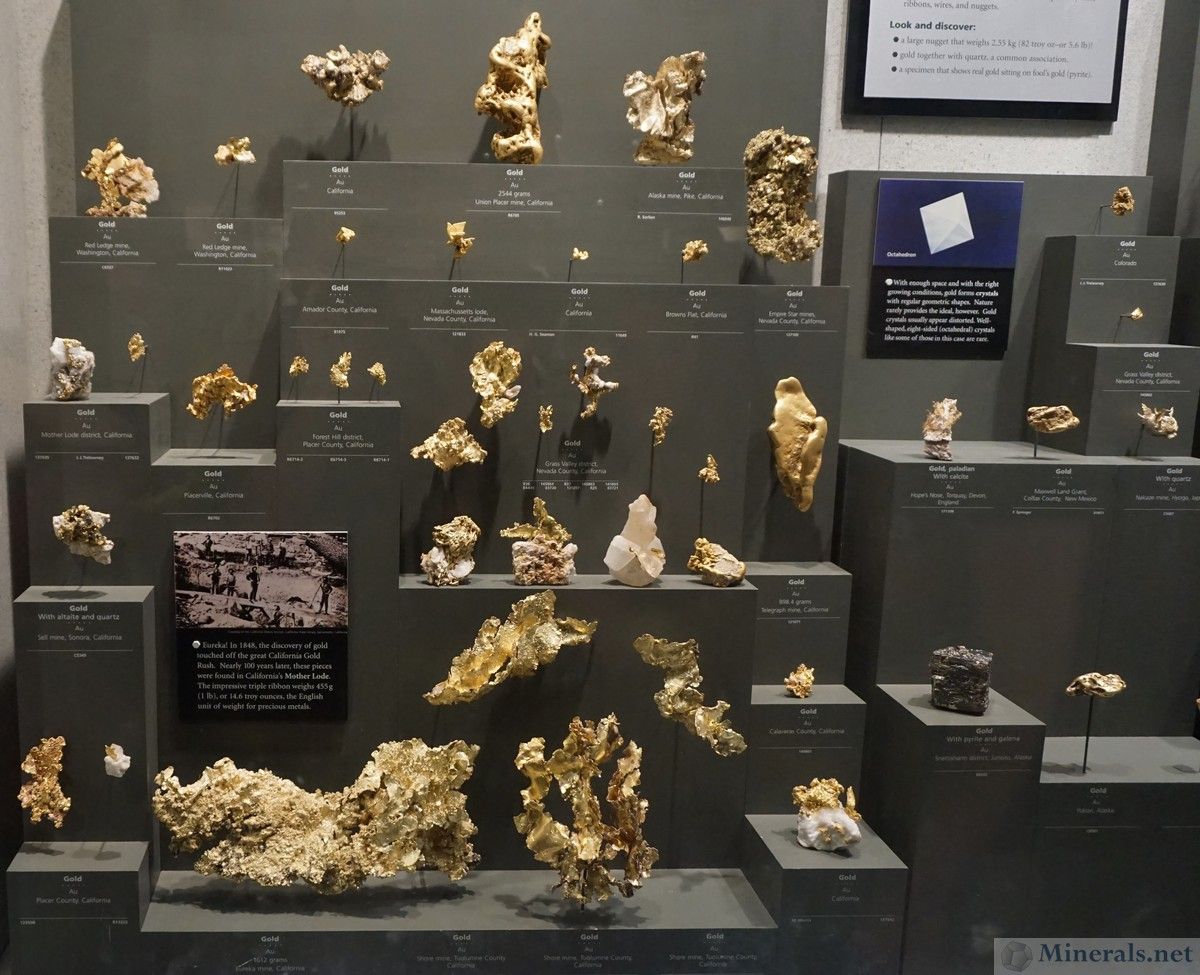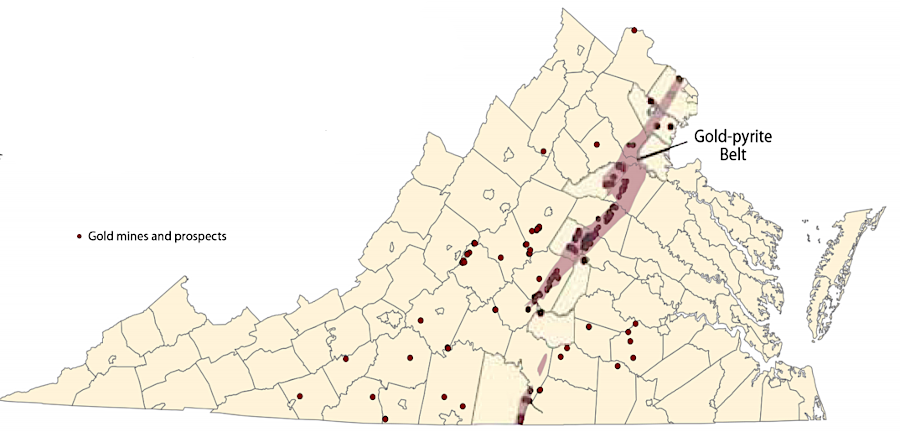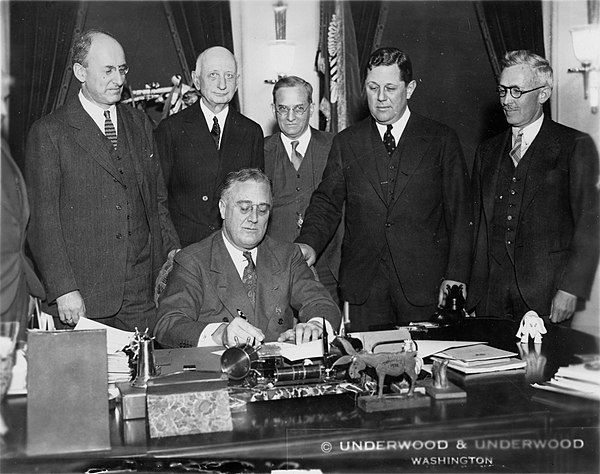Historic Gold Mining in Virginia
by Ken Rock, MSDC Newsletter Editor
One of the most impressive mineral cases at the Smithsonian Natural History Museum's Geology, Gems, & Mineral Hall is a filled entirely with gold specimens. Selected for their beauty from locations all around the world, some are on matrix (mostly quartz), some are crystalline, and some are stream-eroded nuggets chosen for their beauty from locations all around the world. As one might expect, many of the specimens on display are from California, but most people are surprised to see two beautiful specimens from Maryland and Virginia.

Thomas Jefferson's First Report of Gold in Virginia
Most people are surprised to learn that Virginia was one of the first gold-producing states in the nation. The earliest printed reference to gold in the state was in 1782 when Thomas Jefferson reported the following:7

I knew a single instance of gold found in this state. It was interspersed in small specks through a lump of ore, of about four pounds weight, which yielded seventeen penny-weight of gold, of extraordinary ductility. This ore was found on the North side of Rappahanock, about four miles below the falls. I never heard of any other indication of gold in its neighbourhood.7
– Thomas Jefferson, 1788
Thomas Jefferson's report caught the attention of local farmers who were intrigued by the prospect of additional discoveries. Initial efforts consisted of placer mining, the mining of streambed deposits. Flakes of gold had been accumulating for thousands of years at the bottom of Virginia's streams before placer miners arrived, but it did not take long to exhaust the accumulated supply. To find more gold required finding ore in the bedrock, and excavating the ore from which the flakes were eroding into the streams.
Early Lode Mining
The first lode mine was established in Virginia in 1806 less than two miles northwest of Shady Grove Church in Spotsylvania County. In 1825, additional mines were opened, including placer mines and lode mines near the falls of the James River in Amherst County. By 1830, the alluvial deposits most easily obtained were mostly depleted.
Mining a gold vein required excavating a high percentage of waste rock in order to extract the ore. Veins varied in width, reflecting the size of fractures in which hydrothermal fluids crystallized as well as the percentage of gold in those fluids. When miners reached the end of a vein, they continued to excavate in hopes of finding more promising ore nearby.11
The ore-bearing quartz extracted from lode mines had to be crushed before chemicals, including mercury, could be used to separate the gold particles attached to quartz crystals. Pulverizing rock required heavy machinery to grind the ore and expose the crystal surfaces where gold had crystalized as hydrothermal fluids cooled. Placer mining only required the use of a gold pan or other simple equipment that used gravity to separate out gold flakes. In contrast, lode mining was an expensive industrial operation requiring hired workers and capital investment.
Most of the productive veins of the gold belt were less than 2m thick, on the order of 100m long, and mined by surface workings. The first state geologist for Virginia, William Bartram Rogers, noted:12
...we find the auriferous veins in most cases very irregular in their forms: at one point having a thickness of several feet; at another very near to the former, contracting so as only to measure a few inches across. Again, in many cases the vein divides, and the separate portions afterwards unite or send off other branches...
In Morton's mines, the width varies from seven feet to five or six inches. In Booker's the vein forks, thins, and as frequently widens. At the Union mines on the Rappahannock, the breadth varies in some cases from six inches to nearly three feet. In fact, from the dimensions of the vein at any assumed point, no certain inference can be drawn with regard to its extent at other and remote positions.
Unlike many of the Western states that are flowing with massive rivers, Virginia is home to small rivers and creeks that consist primarily of slow flowing water. As a result, most of the gold is found in bedrock and thin pay layers. Early mining in the Virginias consisted of extracting gold from shallow saprolites (soft, disintegrated, mostly decomposed rock remaining in its original place) using mechanical methods, which involved relatively inexpensive labor.
The Gold-Pyrite Belt of Virginia
Most of Virginia’s gold mining was in the “gold-pyrite belt,” a 9- to 16-mile-wide, nearly 140 mile-long northeast trending volcanic-plutonic belt along the eastern side of the Blue Ridge Mountains that extends from Fairfax County to southwestern Buckingham County. Other abandoned gold mines and prospects are scattered widely in the Blue Ridge and Piedmont provinces.

External Factors
Gold production continued to increase from 1840 to 1849 when Virginia produced an average of 3,000 ounces of gold annually. But things changed suddenly when John Marshall, a carpenter and sawmill operator, reported finding gold at Sutter's Mill in Coloma, CA, a small settlement on the American River about 36 miles northeast of Sacramento. Marshall's discovery led to a rush to the California Gold Rush, which drew miners and treasure seekers not just from Virginia, but from all along the east coast.
Some production continued in Virginia on a very small scale and nearly ceased completely during the Civil War. A small resurgence of mining occurred in 1934 shortly after President Franklin D. Roosevelt signed the Gold Reserve Act which was intended to stabilize the money supply in the U.S. at the height of the Great Depression. The Act took away the title of all gold and gold certificates held by private individuals and institutions and transferred it to the United States Treasury. Banks, financial institutions, and the Federal Reserve could no longer exchange U.S. dollars for gold and people owning gold and gold certificates were required to sell to the government at the then statutory (and discounted) price of $20.67 per troy ounce. The Act effectively converted the precious metal from a currency to a commodity.

Immediately following passage of the Act, President Roosevelt changed the statutory price of gold from $20.67 per troy ounce to $35. This price change incentivized gold miners everywhere to increase production and stimulated a revitalization of gold mining in Virginia. Production in 1938 reached a high of 3,000 troy ounces, but the resurgence was short lived because all gold-only producing mines were shut down by the U.S. government to redirect economic attention and labor to the war effort. Gold was last produced in Virginia in 1947 as a by-product of lead and zinc mining.

At its peak, Virginia was the third largest gold producing state in the country. Over 300 mines and areas of prospect existed in Virginia throughout its extensive mining history. Although no mines are active at this time, modern-day prospectors are still drawn to this gold-pyrite belt because of the purity of gold that may be found – evaluated at about 22 karats. In 2021, Virginia's Geology and Mineral Resources Program had documented 301 gold and silver mines, prospects, and occurrences in Virginia.
For more information about gold mining in Virginia and places to try your hand at panning for gold in Virginia, click HERE.
Sources include: Gold, Virginia Energy, Gold and Mineral Resources Program, 2001; Oh Virginia, by Amanda Ellis, Gold Prospectors Magazine, July/August 2018; Gold, Virginia Energy, Division of Mineral Resources, by Palmer Sweet; revised 04/2007, and Investopedia, Gold Reserve Act of 1934 by Adam Hayes, updated June 29, 2022, updated June 29, 2022.
